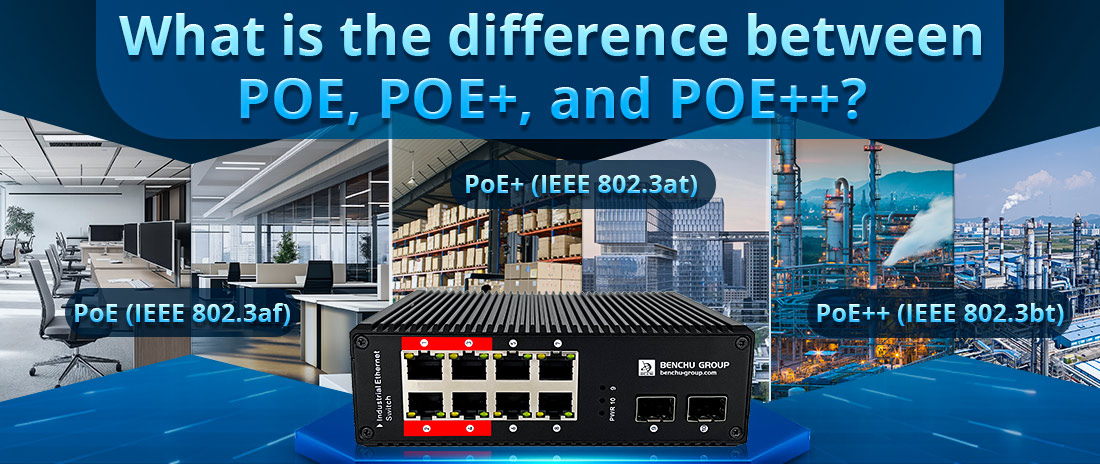
PoE, PoE+, and PoE++ are all standards for Power over Ethernet (PoE), which allows Ethernet cables to transmit both power and data to devices, eliminating the need for separate power cords. Each standard corresponds to different power levels and types of devices they can support. Here’s a breakdown of their differences in terms of power output, compatibility, applications, and technical specifications.
1. Power Output Levels
The key distinction between PoE, PoE+, and PoE++ is the amount of power they can deliver to each connected device:
--- PoE (IEEE 802.3af): Supplies up to 15.4 watts per port with a minimum of 12.95 watts guaranteed at the device, as some power is lost in the cable transmission.
--- PoE+ (IEEE 802.3at): Delivers up to 30 watts per port, with at least 25.5 watts available at the device, accommodating slightly higher-power devices than PoE.
--- PoE++ (IEEE 802.3bt): Has two categories:
--- Type 3 provides up to 60 watts per port (51 watts available at the device).
--- Type 4 offers up to 100 watts per port (71 watts available at the device), supporting the highest power requirements.
2. Transmission Pair Usage
The differences in power levels partly come from the number of twisted-pair cables used for power transmission in each standard:
--- PoE (15.4W): Utilizes two pairs of wires in the Ethernet cable to deliver power.
--- PoE+ (30W): Also uses two pairs, but with higher efficiency and improved power management.
--- PoE++ (60W and 100W): Uses all four pairs in the Ethernet cable, which doubles the power-carrying capacity compared to PoE and PoE+.
This allows PoE++ to provide significantly more power while maintaining the same cabling infrastructure.
3. Device Compatibility and Applications
Each PoE standard is designed with different types of powered devices (PDs) in mind, based on their power requirements:
PoE (IEEE 802.3af):
--- Best suited for low-power devices.
--- Applications: Basic IP cameras, VoIP phones, and simple wireless access points (WAPs) that do not require high power.
--- Common in small office networks or setups where only basic network devices are required.
PoE+ (IEEE 802.3at):
--- Supports devices that require moderate power.
--- Applications: Advanced IP cameras with pan/tilt/zoom (PTZ) features, multi-radio wireless access points, biometric access control systems, and some video phones.
--- Often used in enterprise environments needing enhanced network capabilities and more sophisticated surveillance and access systems.
PoE++ (IEEE 802.3bt):
--- Designed for high-powered, high-performance devices.
Applications:
--- Type 3 (60W): Powers high-performance wireless access points (Wi-Fi 6/6E), multi-sensor IP cameras, video conferencing systems, and advanced building automation devices.
--- Type 4 (100W): Powers devices like LED lighting arrays, larger digital signage displays, point-of-sale terminals, and industrial equipment in IoT (Internet of Things) environments.
Ideal for large-scale installations, industrial environments, and high-density, high-traffic networks.
4. Efficiency and Energy Management
PoE standards have evolved to support more efficient energy use and smarter power management:
--- PoE has basic power management, delivering a constant power level up to its maximum, regardless of actual device needs.
--- PoE+ includes more advanced power management, dynamically adjusting power delivery based on device requirements, which reduces energy waste.
--- PoE++ (IEEE 802.3bt) offers even more sophisticated power management and energy efficiency features, such as dynamic power allocation and sensing and classification mechanisms that ensure devices only draw as much power as they need. This minimizes power loss, improves operational efficiency, and extends the lifespan of devices and switches.
5. Backward Compatibility
Backward compatibility ensures that devices using previous standards can still operate when connected to higher PoE standards. For example:
--- PoE++ switches are compatible with PoE and PoE+ devices, delivering the appropriate power level to each connected device based on its classification.
--- Similarly, a PoE+ switch can power PoE devices but will not provide PoE++ power levels.
This feature enables gradual upgrades, where network administrators can incorporate new devices without replacing all infrastructure at once.
Summary of PoE Standards
| Feature | PoE (IEEE 802.3af) | PoE+ (IEEE 802.3at) | PoE++ (IEEE 802.3bt Type 3) | PoE++ (IEEE 802.3bt Type 4) |
| Maximum Power Output | 15.4W | 30W | 60W | 100W |
| Power at Device | 12.95W | 25.5W | 51W | 71W |
| Pairs Used | 2 pairs | 2 pairs | 4 pairs | 4 pairs |
| Applications | Basic IP cameras, VoIP phones | Advanced IP cameras, WAPs | Wi-Fi 6 APs, multi-sensor cameras | LED lighting, industrial IoT |
| Backward Compatibility | N/A | PoE | PoE, PoE+ | PoE, PoE+, PoE++ Type 3 |
In conclusion, each PoE standard—PoE, PoE+, and PoE++—is designed to address different levels of power requirements and use cases. PoE is suited for basic networked devices, PoE+ for moderate-power devices, and PoE++ for high-power, high-performance devices. These differences enable tailored network design, allowing for scalable, efficient, and simplified setups across a wide range of applications, from small office networks to industrial and enterprise environments.